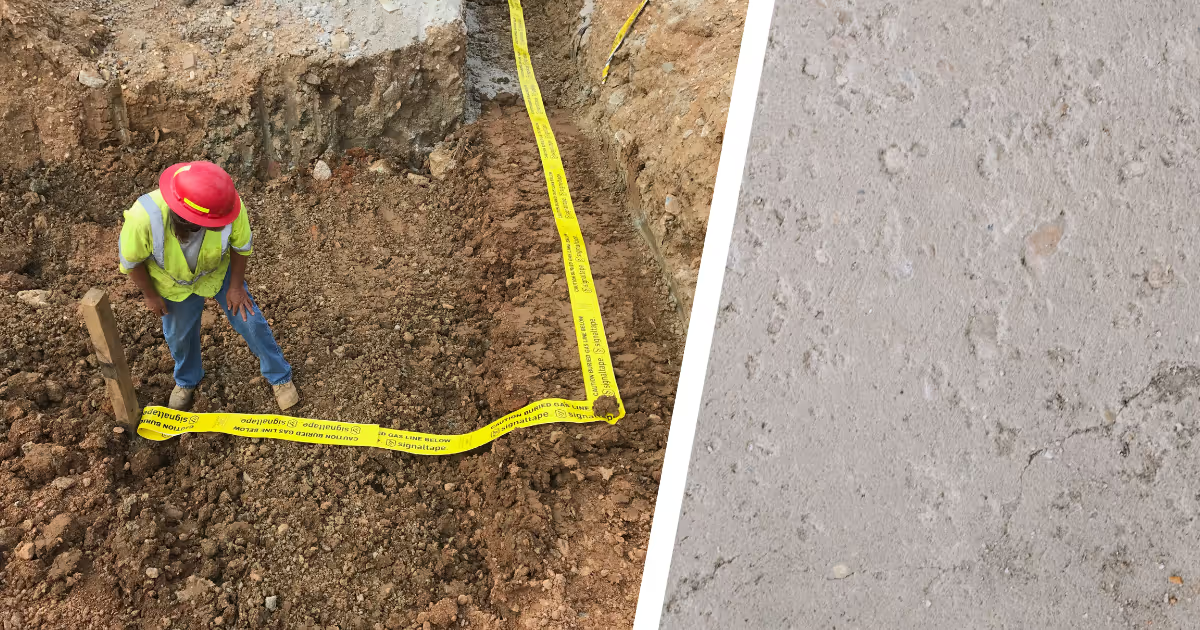
Across the western U.S., utilities are accelerating efforts to underground power lines as part of wildfire prevention grid-hardening programs. While these projects significantly reduce ignition risk, they introduce a different set of engineering challenges, especially in areas where limited cover depth makes traditional installation methods difficult.
For decades, concrete encasement has been the default solution to protect shallow lines. It offers mechanical protection, but it also adds cost, environmental impact, and long-term maintenance considerations. As more utilities seek efficient and sustainable ways to meet construction standards without over-engineering, the role of concrete in underground construction can be re-evaluated.
Concrete encasement remains common for conduits or cables that can’t meet standard cover depths. However, it comes with several trade-offs:
These realities are prompting utilities to re-evaluate how they balance safety, compliance, and sustainability in shallow installations. Many standards allow for concrete or equivalent protection “as approved by the engineer.” That flexibility opens the door for other protective methods that deliver comparable strength and performance without the drawbacks of concrete.
One of the most significant advantages utilities can achieve by reducing reliance on full concrete encasement methods is cost savings, both upfront and over the lifecycle of the infrastructure.
Trenching and backfilling costs rise sharply with depth. Deeper trenches require more excavation, more material handling, and more time, while adding concrete or slurry increases both material and inspection costs. For utilities managing large-scale undergrounding programs, modest reductions in trench depth or concrete use can yield substantial savings when multiplied across many miles of construction.
Industry data reflects the scale of those costs. In California, for example, undergrounding distribution lines in wildfire-prone regions can range from $1.85 million to more than $6 million per mile, depending on terrain and installation method (Source: California Public Utilities Commission). Reducing required cover depth, or eliminating encasement where specifications allow, allows an opportunity to save tens or even hundreds of thousands of dollars per mile.
In addition to direct material and labor savings, reducing reliance on concrete removes curing time and inspection steps that often slow construction progress. Over the long term, avoiding hardened material around the conduit also simplifies future access and repair, reducing both cost and risk.
By specifying engineered mechanical protection systems in place of full concrete encasement where appropriate, utilities can achieve meaningful cost efficiencies while meeting protection requirements and lowering total project costs.
The need for mechanical protection in shallow trenches is clear, but concrete is not the only way to achieve it. Recent advances in engineered materials have created new options that provide protection, detection, and visibility without adding weight or complexity.
Signaltape® Underground Warning Tape is one such solution. Designed specifically for open-trench installation, it combines mechanical strength with high-visibility warning and optional locatable features. Instead of encasing the line, it establishes a layer of mechanical protection above it, alerting excavators before contact and helping maintenance teams locate buried facilities accurately.
When used in accordance with engineering judgment and project standards, Signaltape® can help utilities reduce reliance on concrete while maintaining mechanical protection and compliance with cover-depth requirements.
In shallow installations, the two primary concerns are mechanical protection and detection reliability. The tape’s high-strength core has been independently tested to ASTM standards for tensile strength, confirming its capability to withstand the forces encountered during typical backfill and excavation.
Installation consists of placing the tape directly above the conduit before backfill. Once in place, it establishes a layer of mechanical protection, along with optional detectability that can be located using standard equipment. This provides an ongoing safety advantage: even years later, crews can identify and avoid accidental contact with the line during excavation.
For utilities expanding underground networks to mitigate wildfire risk, every material choice contributes to project efficiency and sustainability. Compared to concrete encasement, Signaltape® offers several advantages:
These benefits make Signaltape® a practical fit for utilities aiming to harden their systems responsibly while improving constructability.
A third-party evaluation conducted by Ting, a national fiber internet provider, illustrates how mechanical protection can play a role in preventing costly excavation damage.
Ting had experienced frequent third-party strikes in new construction subdivisions, particularly when their fiber conduit was installed before other utilities. To address this, they trialed 5,000 feet of underground warning tape at their New Belvedere site in Charlottesville, VA, comparing its performance against standard installations that used only tracer wire.
After one year, the subdivision had two strikes, both in areas where the warning tape was not installed. Within the test area, two separate incidents showed the tape successfully pulled to the surface and alerted excavators before damage occurred.
This real-world result demonstrates how a mechanical warning and detection layer can provide a direct, physical safeguard, alerting crews in the moment, independent of 811 notifications or locate accuracy. For utilities expanding their underground networks, the findings illustrate how integrating mechanical protection systems can strengthen safety and reliability across all phases of construction.
Every project is different, and specifications vary by region and application. As undergrounding efforts expand, engineers and standards teams may want to re-evaluate whether concrete is the best fit for every installation. Questions to consider include:
By evaluating these factors early in design, utilities can make informed, standards-compliant decisions that align with both performance and sustainability goals.
Undergrounding power lines plays a key role in wildfire mitigation, but success depends on selecting the right materials for each environment. Concrete will always have its place, but it is not the only path to reliable, compliant protection.
For shallow installations or areas where maintaining full cover is impractical, engineered warning and protection systems like Signaltape® offer a proven alternative — one that simplifies construction, reduces cost, and supports long-term system integrity.
Utilities committed to hardening their networks for resilience and safety now have an opportunity to rethink traditional assumptions.
The expansion of underground infrastructure creates an opportunity to evaluate protection methods against current project requirements, cost constraints, and performance standards.